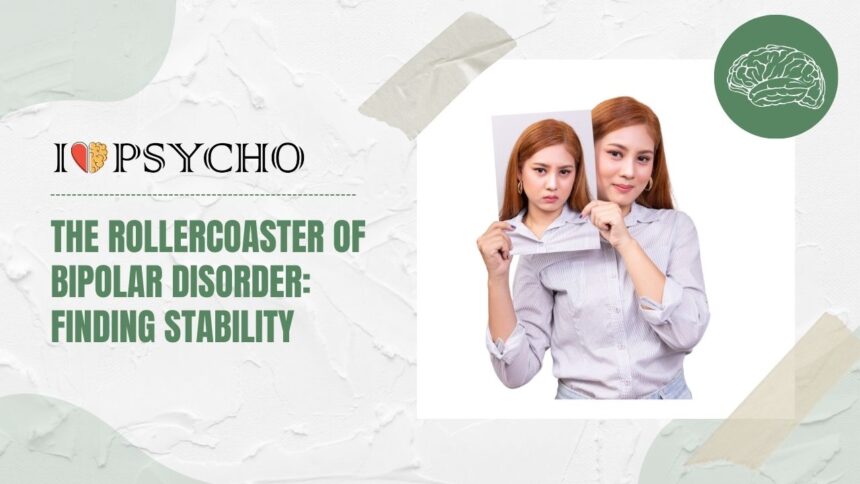Welcome to the wild ride of bipolar disorder – a rollercoaster of emotions, highs, and lows that can leave individuals feeling like they’re on an unpredictable journey. In this blog post, we’ll delve into the complexities of bipolar disorder, explore treatment options for managing symptoms, discuss coping strategies for navigating the ups and downs, and shed light on the importance of self-care in finding stability. Whether you or a loved one are grappling with bipolar disorder, join us as we uncover ways to embrace balance amidst the twists and turns of this challenging condition. Strap in tight – it’s going to be quite a ride!
Understanding Bipolar Disorder
Bipolar disorder is a mental health condition characterized by extreme mood swings. People with bipolar disorder experience intense emotional highs, known as mania or hypomania, and lows, known as depression. These mood shifts can be disruptive to daily life and relationships.
The exact cause of bipolar disorder is not fully understood but likely involves a combination of genetic, environmental, and neurological factors. It is important to recognize that bipolar disorder is a medical condition and not simply a result of personal weakness or character flaws.
Individuals with bipolar disorder may struggle with managing their emotions and behaviors during manic episodes when they feel elated, energetic, or irritable. Conversely, depressive episodes can bring feelings of sadness, hopelessness, and low energy levels.
Diagnosis typically involves a comprehensive evaluation by a mental health professional who considers symptoms reported by the individual as well as observations from family members or loved ones. Treatment options aim to stabilize mood swings through medication management, therapy, lifestyle adjustments, and support systems.
The Symptoms and Types of Bipolar Disorder
Bipolar disorder is a complex mental health condition that can manifest in various ways. The two main types are bipolar I and bipolar II, each characterized by distinct patterns of mood swings.
In bipolar I, individuals experience manic episodes that can be intense and disruptive, often followed by periods of depression. On the other hand, bipolar II is marked by hypomanic episodes which are less severe than full-blown mania but still impactful.
Symptoms of bipolar disorder include extreme changes in mood, energy levels, and behavior. During manic phases, a person might feel euphoric, have racing thoughts, or engage in risky behaviors. Depressive episodes can bring feelings of sadness, hopelessness, and fatigue.
It’s crucial to recognize these symptoms early on to seek proper diagnosis and treatment tailored to the individual’s needs. By understanding the different types and symptoms of bipolar disorder, we can better support those affected by this condition.
Treatment Options for Managing Bipolar Disorder
When it comes to managing bipolar disorder, treatment options play a crucial role in finding stability. Medication is often prescribed to help regulate mood swings and manage symptoms effectively. It’s essential for individuals with bipolar disorder to work closely with their healthcare providers to find the right medication and dosage that works best for them.
Aside from medication, therapy can also be incredibly beneficial in managing bipolar disorder. Cognitive-behavioral therapy (CBT) and psychoeducation can help individuals understand their condition better, develop coping strategies, and improve overall quality of life.
In some cases, lifestyle changes such as maintaining a healthy diet, regular exercise routine, and ensuring an adequate amount of sleep can also contribute to managing symptoms effectively. Finding a balance between treatment modalities tailored to individual needs is key in successfully managing bipolar disorder.
Coping Strategies for Dealing with the Highs and Lows
Bipolar disorder is like riding a rollercoaster, with its exhilarating highs and daunting lows. Coping with these extreme mood swings can be challenging, but there are strategies to help navigate through the ups and downs.
During manic episodes, it’s crucial to channel that excess energy into productive activities like exercise or creative outlets. Finding ways to relax and unwind can also help calm the racing thoughts and impulsivity that often accompany mania.
On the flip side, during depressive episodes, self-compassion is key. Remind yourself that it’s okay not to be okay sometimes. Reach out for support from loved ones or a therapist, and prioritize self-care activities that bring you comfort and solace.
Creating a routine can provide stability amidst chaos. Setting regular sleep patterns, meal times, and daily goals can help regulate your mood fluctuations. Remember, finding what works best for you may take time – be patient with yourself as you explore different coping mechanisms on this journey of managing bipolar disorder.
Navigating Relationships with a Loved One Who Has Bipolar Disorder
Navigating relationships with a loved one who has bipolar disorder can be challenging yet rewarding. Communication is key when dealing with the highs and lows of their mood swings. It’s important to listen actively and offer support without judgment.
Educating yourself about bipolar disorder can help you understand what your loved one is going through. Patience and empathy play crucial roles in maintaining a healthy relationship. Remember, it’s not about “fixing” them but being there for them unconditionally.
Establishing boundaries is also essential to protect your own mental health while supporting your loved one effectively. Encouraging them to stick to their treatment plan and attend therapy sessions can make a significant difference in managing their symptoms.
Above all, remember that love, understanding, and patience go a long way in navigating relationships with someone who has bipolar disorder.
The Importance of Self-Care in Maintaining Stability
Taking care of yourself is crucial when living with bipolar disorder. It’s not just about physical health, but also about nurturing your mental well-being. Self-care means different things to different people, so find what works best for you.
Establishing a routine can provide a sense of structure and stability in your life. Whether it’s sticking to regular meal times or setting aside time for relaxation, consistency can help manage the ups and downs that come with bipolar disorder.
Prioritizing sleep is essential as lack of rest can trigger mood swings. Aim for a consistent sleep schedule and create a calming bedtime routine to promote better sleep quality.
Engaging in activities that bring you joy and reduce stress can significantly impact your overall mental health. Whether it’s painting, listening to music, or going for a walk in nature, make time for things that uplift your spirit.
Remember, self-care isn’t selfish; it’s necessary for maintaining stability and managing symptoms effectively. By taking care of yourself, you’re better equipped to navigate the rollercoaster ride of bipolar disorder with resilience and strength.
Support Systems and Resources for Individuals with Bipolar Disorder
Living with bipolar disorder can be challenging, but having a strong support system in place can make all the difference. Family and friends who understand the condition and offer non-judgmental support are invaluable. Joining a support group can also provide a sense of community and understanding from others who are going through similar experiences.
Therapy is another essential resource for individuals with bipolar disorder. A therapist can help navigate the ups and downs, develop coping strategies, and provide a safe space to talk openly about thoughts and emotions. Medication management is crucial for many individuals with bipolar disorder, so having a psychiatrist who specializes in mood disorders is key.
Online resources such as forums, websites, and educational materials can also provide valuable information and connect individuals with helpful tools and tips for managing their condition effectively. Remember, reaching out for help is not a sign of weakness but rather a brave step towards finding stability in the rollercoaster of bipolar disorder.
Conclusion
In the rollercoaster journey of bipolar disorder, finding stability is a continuous process that requires understanding, patience, and resilience. By recognizing the symptoms, exploring treatment options, implementing coping strategies, nurturing relationships, prioritizing self-care, and seeking support when needed, individuals with bipolar disorder can navigate their way towards a more stable life.
Remember that each person’s experience with bipolar disorder is unique. What works for one may not work for another. It’s essential to listen to your body and mind, communicate openly with your healthcare provider and loved ones, and never hesitate to seek help when you need it.
While there may be challenges along the way, know that finding stability is possible. With dedication and determination, you can learn to manage the highs and lows of bipolar disorder effectively. Keep moving forward on your journey towards stability – you are not alone in this fight.









